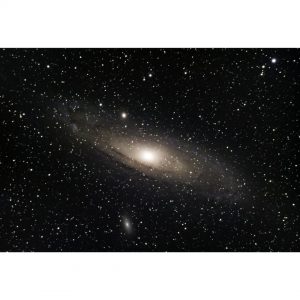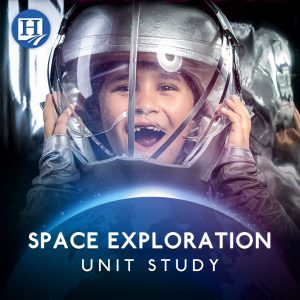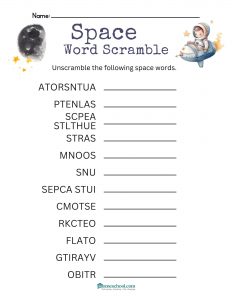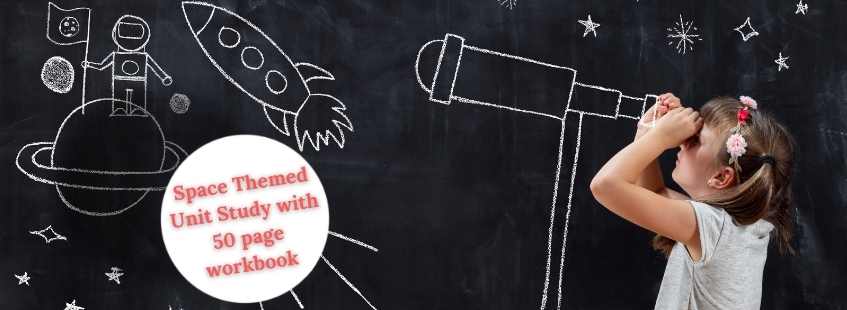Space. The final frontier… or is it? Indeed, the study of space, otherwise known as astronomy, is a field of study that is nearly limitless. Scientists continually discover new and amazing things in the “great beyond…” and science careers are fascinating! It’s a great opportunity for homeschool astronomy study, starting when our children are young. Certainly, awakening interest in studying the cosmos, or the world beyond our planet, is an important aspect of education.
The study of space is the investigation of everything outside the atmosphere of Earth. Astronomy studies celestial objects. Things such as stars, galaxies, planets, moons, asteroids, comets, and nebulae. As well as, the processes of those celestial objects. For example, supernova explosions, gamma-ray ray bursts, and cosmic microwave background radiation. (What? There are microwaves in outer space?)
Super Events for Homeschool Astronomy
First and foremost, start your homeschool astronomy and space unit study with these important space moments! Here are a few in particular:
- February 20, 1947: The first animals were sent to space. What did they send?? Fruit flies!
- June 14, 1949: The rhesus monkey, Albert II, became the first primate and first mammal in space.
- October 4, 1957: Sputnik 1 became the first satellite to be launched by man into space.
- April 12, 1961: Yury A. Gagarin became the first person in space.
- July 20, 1969: Apollo 11 took the first humans to walk the moon.
- April 25, 1990: The Space Shuttle Discovery placed the Hubble Space Telescope into orbit.
- August 6, 2012: NASA’s Curiosity rover successfully landed on Mars.
- July 14th, 2015: NASA’s New Horizons spacecraft completes a successful flyby of Pluto.
World Space Week
World Space Week happens each year on October 4-10 in over 95 countries. This is “an international celebration of science and technology and their contribution to the betterment of the human condition.”
Its History
First, let’s start by asking the obvious question: why dedicate an entire week to space? World Space Week is a way to commemorate two significant space-related events in 1999. The United Nations declared October 4th through October 10th as World Space Week in recognition of the first human-made satellite that launched on October 4, 1957 — Sputnik! Sputnik paved the way for space exploration by taking the first tentative journey.
Further, ten years later on October 10, 1967, The Outer Space Treaty went into effect. The Outer Space Treaty, also known as the United Nations Treaty on Principles Governing the Activities of States in the Exploration and Peaceful Uses of Outer Space, including the Moon and Other Celestial Bodies, was signed on that date to encourage space exploration. In fact, the Treaty is the foundation of international space law!
World Space Week is all about supporting space studies, as well as educating the public about the universe and our galaxy or solar system in particular. This international celebration brings together nations, as well as science and technology. The main focus of studies and programs during World Space Week is to explore how studying outer space directly leads to human betterment and appreciation of our reality.
It’s a sad fact that the space program has been limited, and World Space Week aims to show the public interest and desire for greater space exploration, knowledge, and even the consideration of possible options that lay within space for economic development.
Its Importance
In fact, you may be surprised to discover how much outer space and astronomy affects science and the world we live in. It’s important to take care of our planet, but our world does not exist in a vacuum. It is guided and influenced by our solar system and the other planetary bodies within it. Not only can a space study encourage interest in this fascinating subject, but it can also give greater awareness and perspective of both the fragility and strength of our world.
the other planetary bodies within it. Not only can a space study encourage interest in this fascinating subject, but it can also give greater awareness and perspective of both the fragility and strength of our world.
As far as we know, Earth is the only planet with life. In fact, the great majority of organisms on earth, including ourselves as humans and our own loving pets, need a proper supply of oxygen and water to survive. When we study space, we learn how limited this supply is for the living conditions we need. In effect impresses our need to take care of what we have. Of course, our planet is special — and a space study reveals that!
In addition, there are several logical reasons to study and explore space. In fact, NASA and our own government in the U.S. have made many statements about the benefits of the space program in terms of national security, scientific discovery, and economic benefit. However, there are many more, less tangible, reasons to study outer space. Notably, while probably the most compelling, these are the least mentioned. Especially since they can’t be analyzed on a chart or defined by numbers.
- Curiosity. Naturally, curiosity drives many actions, and a simple underlying basis for space exploration is the fact that we are curious about what is out there. Importantly, what surrounds our world? Particularly our home? Indeed, at our roots as humans, we are explorers.
- Technology. Surprisingly, without space programs, we wouldn’t even have GPS — and most of us will attest to its importance in our daily lives. Without technology created thanks to space studies, we wouldn’t have as accurate weather information and prevention as well. Furthermore, without space programs, we wouldn’t even have ultraviolet filters for our glasses.
- Asteroids, Solar Flares, & Comets. Space programs, observation, telescopes, and satellites help make us aware of potential dangers to our planet. Rogue asteroids or objects can damage our world — but space observation may give us a chance to prepare, and possibly even save our planet.
- Space Mining. When governments mention the possibility of economic benefit, this includes the potential for gathering abundant natural resources found in space. Our resources are being depleted, but space provides an option for sustainability.
- Pushing Boundaries. It is fundamentally human to push our boundaries. Pushing these boundaries results in discoveries that have led to new technologies, medicine, and procedures to prolong life and the quality of that life, among other accomplishments. Without humans pushing boundaries, we wouldn’t be living in the 21st century with the modern conveniences that many of us enjoy.
Fun Facts About Space
There is so much about space that we haven’t yet discovered, and much of what has been found is still unknown to most people. Amaze those in your life by passing along these fun facts! Did you know any of them already?
- Water ice has been found throughout the solar system. Surprisingly, though water ice was once considered a rare find in space, it has been spotted on the moon, in Mercury’s shadowed craters, at Mars’s poles, and in the smaller moons of Jupiter and Saturn as well!
- Spacecraft have visited each planet. Did you know that NASA has sent spacecraft to each planet in our solar system, including the dwarf planets Pluto and Ceres? In fact, we’ve been exploring long enough now to have firsthand information about each planet!
- Mercury is shrinking. Metrics sent by the MESSENGER spacecraft have revealed that tectonic plates have shifted within Mercury and the planet is slowly shrinking. For several years, scientists believed that Earth was the only tectonically active planet in our system, but that changed as of 2016 thanks to the data by MESSENGER.
- Extreme microbes have been discovered. Microbes are considered a form of life that can survive in some of the harshest environments. These microbes have been found on Mars and due to the presence of water ice on several moons and other planets, astronomers wonder whether these microbes could exist elsewhere in our solar system.
- Pluto used to be geologically active. Thanks to photos sent back from Pluto by the New Horizons spacecraft in 2015, scientists learned that Pluto has numerous mountains reaching up to 11,000 feet tall. These mountains and the uneven terrain suggest geological activity in the past, but the source of that activity continues to stump astronomers.
- Neutron stars can rotate up to 60 times per second. Neutron stars form from supernovae (dying stars that collapse on themselves), which gives them the incredible energy to spin so quickly. Apparently, under the right circumstances, they can even spin up to 600 times per second.
- The astronauts’ footprints on the moon remain. The moon lacks an atmosphere, which means there doesn’t exist any wind or weather to erode their footprints. Those footprints will likely remain on the moon for the foreseeable future.
- The sun takes up 99% of our solar system’s mass. The sun is so dense that it accounts for most of the solar system’s mass; which is exactly how it dominates the planets and conducts the gravitational orbit.
- Saturn is not the only planet with rings. Rings have been spotted on all of the outer planets in our solar system in addition to Saturn. This includes Jupiter, Uranus, and Neptune. The rings vary greatly per planet and none are as spectacular as Saturn’s, but the rings are present nonetheless. Rings have even been spotted on the asteroid Chariklo!
- The sun provides the Earth with more energy in one hour than it could use in one year. In comparison to the solar energy provided by the sun, Earth uses a shockingly small amount. The use of solar energy has been increasing by 20-30% each year for the past 15 years or so, but it still only accounts for 0.7% of the world’s annual electricity usage.
Space Exploration Book List
Take this list to your local library, or add some space books to your home library by purchasing through the Amazon link below!
Nonfiction:
- Kid Astronomer: The Space Explorer’s Guide to the Galaxy by Applesauce Press
- Space Encyclopedia, 2nd Edition: A Tour of Our Solar System and Beyond by National Geographic Kids
- Constellations for Kids: The Stories of the Stars (Ages 3-5) by Ann Pearson
- Constellations for Kids: An Easy Guide to Discovering the Stars (Ages 6-9) by Kelsey Johnson
- Can’t Get Enough Space Stuff: Fun Facts, Awesome Info, Cool Games, Silly Jokes, and More! by National Geographic Kids
- Solar System for Kids: A Junior Scientist’s Guide to Planets, Dwarf Planets, and Everything Circling Our Sun by Hilary Statum
- The Mysteries of the Universe: Discover the Best-Kept Secrets of Space by Will Gater
- How Spaceships Work by Lonely Planet Kids
Fiction:
- The Magic School Bus: Lost in the Solar System by Joanna Cole and Bruce Degen
- There Was a Black Hole that Swallowed the Universe by Chris Ferrie
- If You Had Your Birthday Party on the Moon by Joyce Lapin
- Star Stories: Constellation Tales From Around the World by Anita Ganeri
- Alien of Astronomy (Junkyard Adventures) by Tevin Hansen
- Moon’s First Friends: A Heartwarming Story About the Moon Landing by Susanna Leonard Hill
- Star Man’s Son by C C Archambeault
- Ada and the Galaxies by Alan Lightman and Olga Pastuchiv
Activity Books:
- Astronomy Activity Book for Kids: 100+ Fun Ways to Learn About Space and Stargazing by Aurora Lipper
- Paint by Sticker Kids: Outer Space by Workman Publishing
- Solar System Coloring and Activity Book for Kids by Brenda MacArthur
- Super Space Sticker Activity Book by National Geographic Kids
- The Everything Kids’ Astronomy Book: Blast into outer space with stellar facts, intergalactic trivia, and out-of-this-world puzzles by Kathi Wagner
Homeschool Astronomy Activities
There are so many fun activities that can be done with an astronomy/space focus. Here are a few ideas to help you get started!
- Grab a Telescope and Learn about Homeschool Astronomy and the Constellations: Use black construction paper and stickers to make the stars of the constellation. Then, connect the stars with white chalk to see the constellation forms!

- Build a Moon Habitat: Begin by rolling up newspaper into strong tubes and securing it with tape. Next, use three tubes to create a triangle. Make and use multiple triangles to make a moon habit structure. Finally, cover it with a bedsheet to complete the lunar building!
- Use these flashcards to identify and learn about the planets and other celestial entities!
- Ask a Scientist: Do you have a question that you need to be answered? NASA’s Ask a Scientist can help you find answers to your space questions!
Homeschool Astronomy Field Trips
While much can be (and is!) learned through reading, learning through seeing, hearing, and experiencing can make more of an impression. Choose one or more of these field trips to enjoy with your budding astronomer.
- Plan a Planetarium Trip: Learn about the stars and planets with a trip to your local planetarium. If there isn’t one near you, try this online planetarium for backyard star fun! If you are lucky enough to have a space center near you, make a day of it!
- Take a Space Flight: The American Museum of Natural History offers a virtual trip from the Earth to the International Space Station to the Moon and through the stars!
- Take an Overnight Trip to Stargaze: Make a reservation, pack a bag, load up the car, and drive far away from city lights for a night of family stargazing. If you live far enough away from a city to be able to clearly see the stars at home, take some snacks, pillows, and blankets outside, make a comfy spot on a trampoline or truck bed, and make some memories with your kids!
- Bonus Homeschool Astronomy Activity: If possible, plan a trip to and explore the Kennedy Space Center in Florida! They have so many amazing things to see and learn. It is sure to be a trip your kids will never forget!
Space Exploration Snacks
Take the learning into the kitchen with these homeschool astronomy snacks!
- Make Your Own Constellations: Using small pretzel sticks and mini marshmallows, create your own edible version of your favorite constellations!
- Learn about Moon Phases with Oreos: First, pull apart the cookie to reveal the

Sample page from the free Homeschool Astronomy workbook cream filling. Then scoop away the filling to represent the full moon, waxing gibbous, first quarter, waxing crescent, new moon, waning crescent, last quarter, and waning gibbous. Finally, discuss!
- Galaxy Jello Cups: First, layer blue and purple jello in a clear cup. Then, once solidified, add some whipped cream and space sprinkles for a fun snack! Lastly, enjoy!
- Rocket Fruit Kebobs: Begin by layering fruit chunks in the shape of a rocket for this healthy snack! Next, use a watermelon triangle for the top, a chunk of banana, a chunk of kiwi, a strawberry, and a chunk of canteloupe cut to look like flames for the final piece. Finally, enjoy your snack!
- Starry Sky Cupcakes: Start by make some chocolate cupcakes. Then top them with blue icing, and add star sprinkles to make the night sky! Lastly, enjoy the tasty starry sky!
Homeschool Astronomy Learning Videos
Make your kids’ day by adding a little screen time with these fun and educational space videos!




